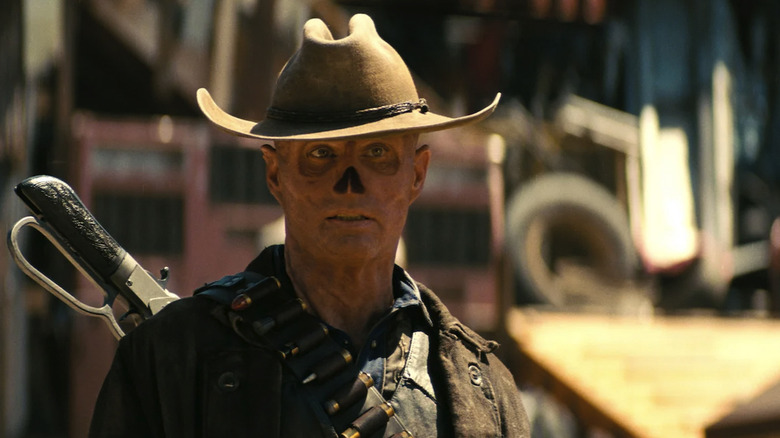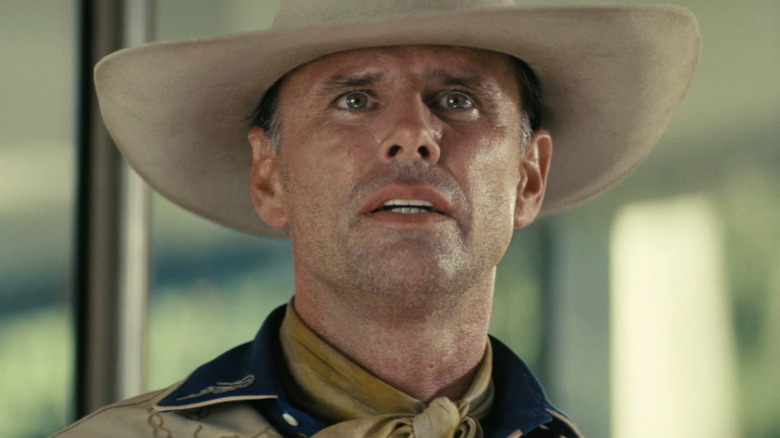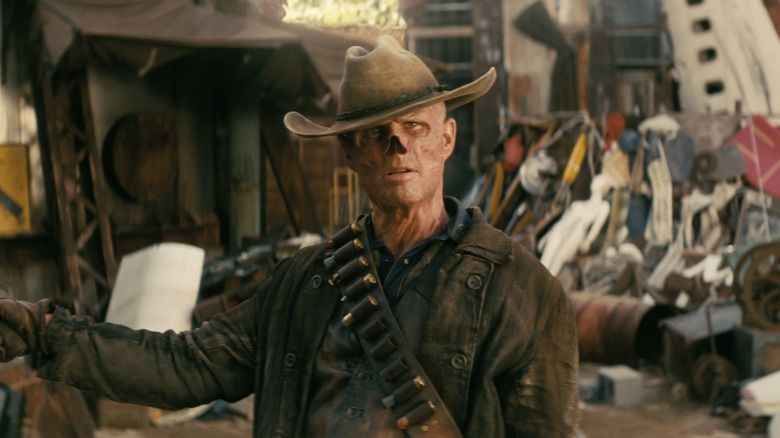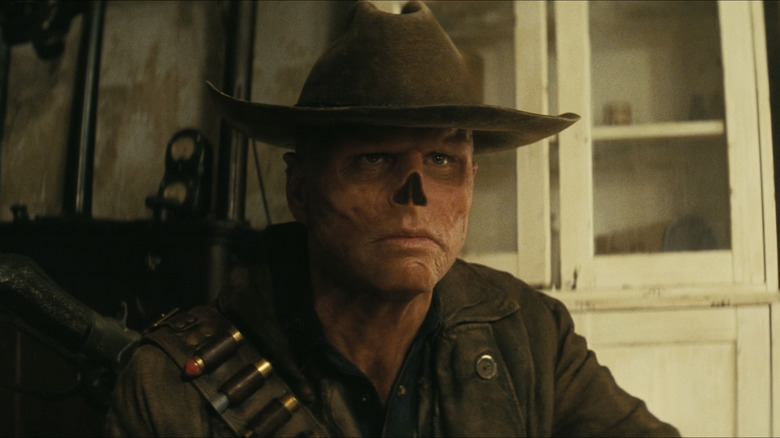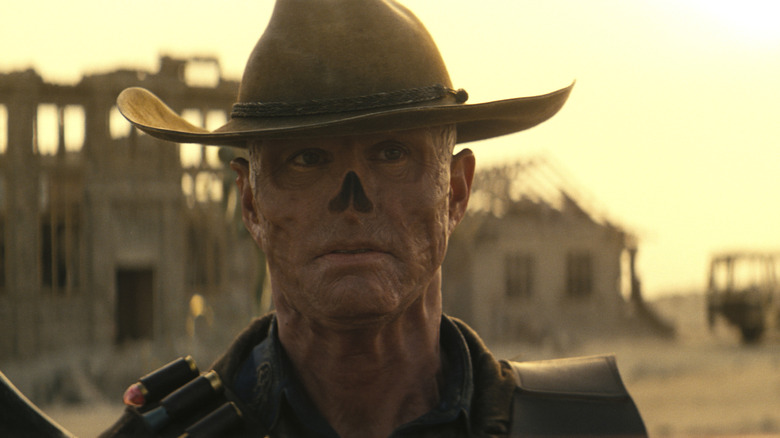How Walton Goggins Became Fallout's Hideous (But Somehow Still Handsome) Ghoul
"Fallout," Prime Video's stellar adaptation of the popular video game, is proving a hit with critics and fans since its April 10 debut. The fact the show has managed to faithfully recreate the expansive world of the video games on which it's based is impressive enough. But "Fallout" is also noteworthy for debuting original characters that fit effortlessly into the universe first established back in 1997, when the first game arrived. Among those characters, Walton Goggins' The Ghoul might be the series' most compelling.
In his 2016 review of HBO's "Vice Principals," The New York Times' Mike Hale wrote that Goggins "makes a habit of being the best thing about the television shows he's in." That arguably hasn't changed since, with the "Righteous Gemstones" star delivering an effortlessly charismatic turn as the irradiated bounty hunter in "Fallout." From the very beginning, Goggins' mutated gunslinger exudes an alluring magnetism, which, considering the actor was covered in extensive prosthetics, is pretty impressive.
Unfortunately, Goggins had to endure what sounds like an intense process in order to project his performance through the makeup, with the actor revealing that he spent hours in the makeup chair only to realize that he could barely talk, let alone act once he got on set.
The Ghoul in Fallout
In the "Fallout" video games, there are various types of Ghouls. All of them are irradiated humans that populate the post-nuclear wasteland, but some have become rabid while others have retained their humanity, even as their bodies endure radiation-induced decay. The noseless beings can be encountered simply by roaming the wasteland, accosting players and attempting to devour their flesh for sustenance. But the non-rabid ghouls are also found in many of the games' makeshift cities, providing help and setting side quests for players.
In the Prime Video series, there are examples of both kinds, but in Goggins' character's case, not only did the show creators decide to keep The Ghoul character "hot," they ensured the itinerant rogue retained his memories and humanity, despite being 200 years old. The result is a character that is neither antagonist or protagonist. The Ghoul occupies one of the many gray areas thrown up by the series' post-apocalyptic circumstances, demonstrating a ruthless and calculating side while also revealing himself to be a product of tragedy.
The Ghoul's former, pre-nuclear persona was that of Cooper Howard, a Western movie star whose wife, Barb (Frances Turner), was a Vault-Tec employee working to construct the vaults that would protect citizens against the impending nuclear blast. The opening scene of the series depicts Howard and his daughter, Janey (Teagan Meredith), witnessing the first bombs drop on Los Angeles before escaping on horseback. But the version of Howard we meet some 200 years later is a much different character. Exhumed from the ground by a trio of bounty hunters, Howard is revealed to have become The Ghoul, a noseless, decaying, ruthless, intelligent gunslinger. Creating the look to accompany that persona, however, proved to be a complex and involved process.
Transforming Walton Goggins into The Ghoul
In a Vanity Fair piece published before the debut of "Fallout," executive producer and director of the first three episodes Jonathan Nolan explained how creating Walton Goggins' Ghoul look was a balancing act:
"You have to be extremely careful with it when you're putting a full appliance on someone's face because you hired that actor for a reason. Their face is their instrument. [You want] the tiny little expressions and changes that they make."
That was a significant challenge for prosthetics designer Vincent Van Dyke, who was tasked with creating a visually striking look for The Ghoul that still allowed Goggins' to project his performance. Once Van Dyke had planned the look of the prosthetics, it was up to Jacob Garber, makeup artist and head of the prosthetic department, to apply the pieces and finalize The Ghoul's on-screen appearance. That process was nothing short of grueling, if Goggins' recollection is anything to go by.
Speaking at the Deadline Contenders Television panel, the "Justified" star characterized the whole experience of becoming The Ghoul as "extremely anxiety-provoking," with the initial makeup tests becoming five-hour marathon sessions. The actor added:
"I knew that this was going to be an intense experience being in that [makeup] chair. I didn't take the time to really think about, because I don't know what I would have done, what my reaction would have been to how long it was going to take."
The initial tests weren't just about applying the prosthetics, either. There were still conversations to be had about various elements of The Ghoul's appearance, and even after the look was finalized, there was more trouble to come for Goggins.
The Ghoul's look was more than prosthetics
The initial makeup tests weren't the only challenging part of creating The Ghoul's look. Once Jacob Garber had applied the prosthetics to Walton Goggins, there was still much more to be decided. As the actor explained at the Deadline panel:
"We talked ad nauseam about how we wanted this to look and how I could communicate with the audience and you could still see that it was me [...] At one point we talked about putting in eye contacts, tried that, and immediately said, 'No, your eyes make you human,' so we got off that. By the time we were ready to go, Geneva [Robertson-Dworet, producer and co-creator] and Graham [Wagner producer and co-creator] came over, we all looked at it one last time and said, 'Ok, this is what we're going to go with.'"
But even after finalizing the look of The Ghoul, Goggins actually had to perform, which turned out to be trickier than he'd assumed. The actor explained that when arrived for the first day of shooting in New York, the temperature was 106 degrees, which posed an immediate problem. According to Goggins, he "immediately sat down on a log and said, 'Oh my god, I'm getting too old for this [expletive].'" Evidently, the heat had caused the actor to sweat so much that it started "pouring out of [his] eyes." Director Jonathan Nolan recalled that moment in his Vanity Fair interview:
"The first day we were shooting with Walton in makeup, he comes to set and I'm looking at him, like, 'Walton...are you crying?' He just had sweat leaking out of the prosthetics under his eyes because it was so hot."
While dealing with the heat, Goggins also had to overcome another challenge: not being able to talk.
The Ghoul wouldn't be The Ghoul without Walton Goggins
After having endured a laborious process to finalize the prosthetics, then being caught off-guard by the heat during the first day of filming, Walton Goggins then discovered that he was unable to actually talk while in costume. As the actor explained during the Deadline panel, when he put in the retainers designed to give The Ghoul some suitably yellowed and degraded teeth, he couldn't speak. However, after some trial and error, Goggins managed to overcome his various issues, and explained that by the end of filming, not only had he mastered the art of delivering lines through his retainers, he and the team has reduced the makeup process to "about an hour and 45 minutes to two hours and 15 minutes in the chair every day."
Throughout the creation of "Fallout," it seems Goggins had some significant input into not just his character's look, but the show in general. The actor revealed on Late Night with Seth Meyers that he wanted audiences to "lean into" the look of The Ghoul and told the producers he wanted to "do Kris Kristofferson if he were 250 years old and had been walking the wasteland, and had been drinking all night." Goggins even helped organize the mini-"Justified" reunion within "Fallout," suggesting his former colleagues for parts in Prime Video's series.
Without Goggins, it seems "Fallout" could have been a significantly different show, which only speaks to the actor's continuing run as being "the best thing about the television shows he's in."
